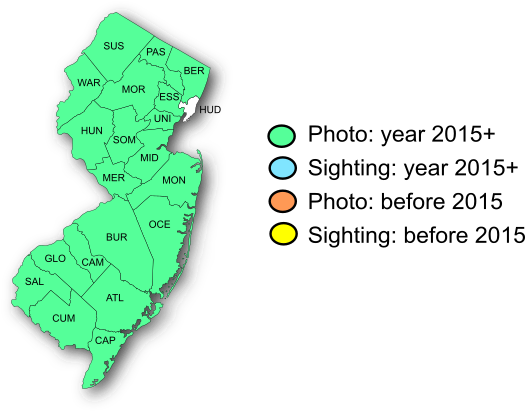New Jersey Butterfly Club
A chapter of the North American Butterfly Association (NABA)
Horace's Duskywing
Erynnis horatius
Identification: Very small—1.45" but the largest Erynnis in NJ. Above: FW mottled dark brown with little gray overscaling. Several glassy spots in FW, including a wrist "bracelet," and 2 additional spots aligned with it. and a small, white, cell-end spot. HW dark brown with inconspicuous, blurry, submarginal spots. Female is much more conspicuously mottled above on both wings and glassy spots in FW are much more prominent. Below: FW and HW in both sexes dark brown, with a few glassy marks usually visible in FW; lacks pale spots along leading edge of HW. (However, like all duskywings, Horace's is most often seen spread-winged, so the presence or absence of these spots may be difficult to determine.) Other: Palps ("face") usually white, and white extends as a ring over the eye. Similar species: Juvenal's Duskywing is virtually identical above except that the female is less highly patterned than Horace’s and has smaller glassy spots in the FW, and the male has hairlike white overscaling lacking in Horace’s male. Below, Juvenal's has 2 pale spots along leading edge of HW that Horace's lacks. Juvenal's also has a dusky "face" and lacks a white ring over the eye. Wild Indigo Duskywing is slightly smaller, blacker above (especially the male), with smaller glassy spots in FW, and lacks cell-end spot above.
NJ Status and Distribution: Resident. A primarily southern species that is near the northern limit of its range in NJ. Uncommon but widespread in northern counties; more common in southern counties.

Habitat: Dry fields near woods with oaks. Often visits gardens, especially those near oak woodlands.
Flight Period: Two or three broods, mainly from May into June and July into August, with possibly a partial third from September into October. The second brood is by far the largest. Extreme dates: North Jersey 4/29—10/25; South Jersey 3/23—10/24.
Caterpillar Food Plants: Oaks (Quercus), especially young trees with tender leaves.
Overwintering Stage: Caterpillar.
Good Locations: Any dry field near oaks is worth checking.
Comments: From April through June care must be taken to distinguish Horace's from Juvenal's as both are flying, and the less-common Horace's may be overlooked. However, a large duskywing seen from late June on is almost certainly Horace’s, as Juvenal’s are not known to have a second brood in NJ. In North Jersey in summer the active field observer is lucky to see 1 or 2 Horace's per day, whereas in south Jersey 5 or more on most days would not be unusual.



